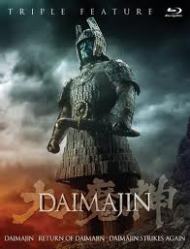Daimajin ![]()
Return of Daimajin ![]()
Daimajin Strikes Again ![]()
Daimajin: Lord Hanabasa assures his two children that recent earthquakes are not to be feared as their good god will protect them. The common villagers have a different view, gathering to perform a ceremony to keep an evil spirit locked away in a giant statue. Samanosuke, the traitorous Chamberlain, takes advantage of the confusion to murder the lord and seize control, but fails to kill Hanabasa’s children. Protected by a swordsman and a priestess for ten years, they come of age hiding on their god’s mountain. The rightful heir sets his mind on freeing his people from Samantha’s cruel rule, while that evil man decides to crush the villagers’ spirit by destroying the giant idol, both actions potentially causing the massive “Majin” to awaken.
Return of Daimajin: The ruler of Mikoshiba sets his sights on the neighboring lands of Nagoshi and Chigusa, that sit on either side of a lake that contains the god’s island. Both are crushed, but the young lord of Chigusa and the daughter of the Lord of Nagoshi escape to the island. When the invaders decide to destroy the statue of the god, they earn the wrath of Majin.
Daimajin Strikes Again: A wounded woodsman returns to his village, explaining that a warlord had captured the missing men and forced them into hard labor building a fort. Only he had escaped by crossing the god’s mountain. With the coming snow, the local lord cannot send troops. Someone must travel to the compound, over the forbidden mountain, and tell the men the only route to escape. When no one takes on the quest, four children sneak out to rescue their fathers and brothers. It is only a matter of time before all this trapsing on sacred ground wakes the Majin.
Discovering the Daimajin movies twenty-five years after their release was a delightful surprise. Good daikaiju is rarer then a funny Ben Stiller movie (percentage-wise) and a period one with samurai… Well, to the best of my knowledge, these are it. All three were made in 1966, and released a year apart. The studio had hit pay dirt with Gammera, the gigantic turtle, and were looking for another giant monster franchise; something different. They found it.
At first I was loathe to categorize Daimajin as daikaiju. It feels like a straight samurai adventure, with a bit of Hong Kong fantasy mixed in toward the end. But city stomping is an automatic entry pass into the daikaiju club, and Majin gets in some good stomping, even if the buildings are a bit more primitive than normal.
Perhaps it is just that I am so used to the human story being unimportant filler between monster misdeeds (see about 20 of the Godzilla pictures). Here the story, not the smashing, is the point, not that the smashing isn’t worth the price of admission on its own. The story is a simple heroes tale, like 90% of Japanese sword epics, with that simplicity strengthening the drama. The characters are well defined, and pure, good or evil as the case may be.
There is on exception: The god. He’s a world of contradictions. It is not clear if Majin is “the god” but no one else shows up to lay claim to the title. If he is the good god that is mentioned, he’s not all that sympathetic to his people’s pain, as only a personal insult and a woman’s tears gets him moving, and collateral damage doesn’t phase him. If he is the demon the villagers feared, he’s amazingly just (Old Testament just) and a better neighbor than many of the humans. It leads to a fascinating world.
The Return of Daimajin is a rehash sequel: same plot, though with less buildup, same beautiful cinematography, though not quite as attractive, same monster attack and rescue, though not as exciting. The characters are similar, some lines repeat, and the entire structure of the film matches its predecessor. That doesn’t make it bad, just unnecessary. If Daimajin didn’t exist (or you are unable to find it), I would rate this one reel higher.
Daimajin Strikes Again manages to be avoid the rehash label, but it is still the weakest of the three. OK, it doesn’t avoid it by that much. There is once again an evil warlord who forces peasants into grueling labor and tortures them and the Majin waits for act three to show the level of his displeasure. What’s different is the lack of samurai action. The protagonists are children and in place of sword play we get a boy scout adventure through the wilderness. While it is reasonably presented, it isn’t very interesting. I give Strikes Again points for treating kids with respect, without silly jokes or sanitizing the danger, but respect is insufficient. It starts well, and ends better, but you might drift off in the middle.
While you don’t need to go running off to see all three, the original Daimajin is a must see.
